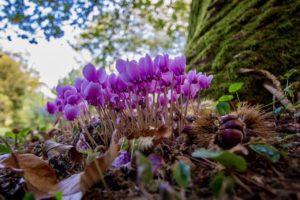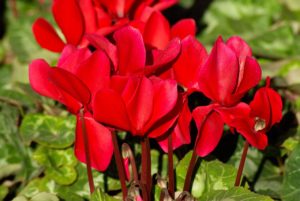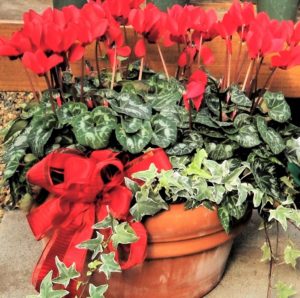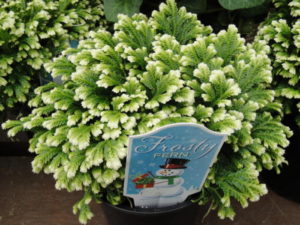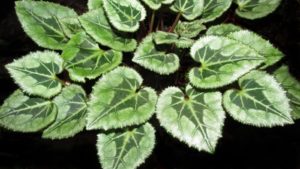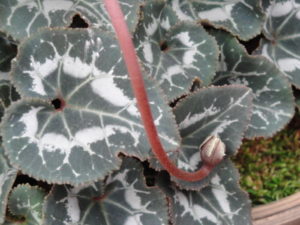It’s Time For Cyclamen!
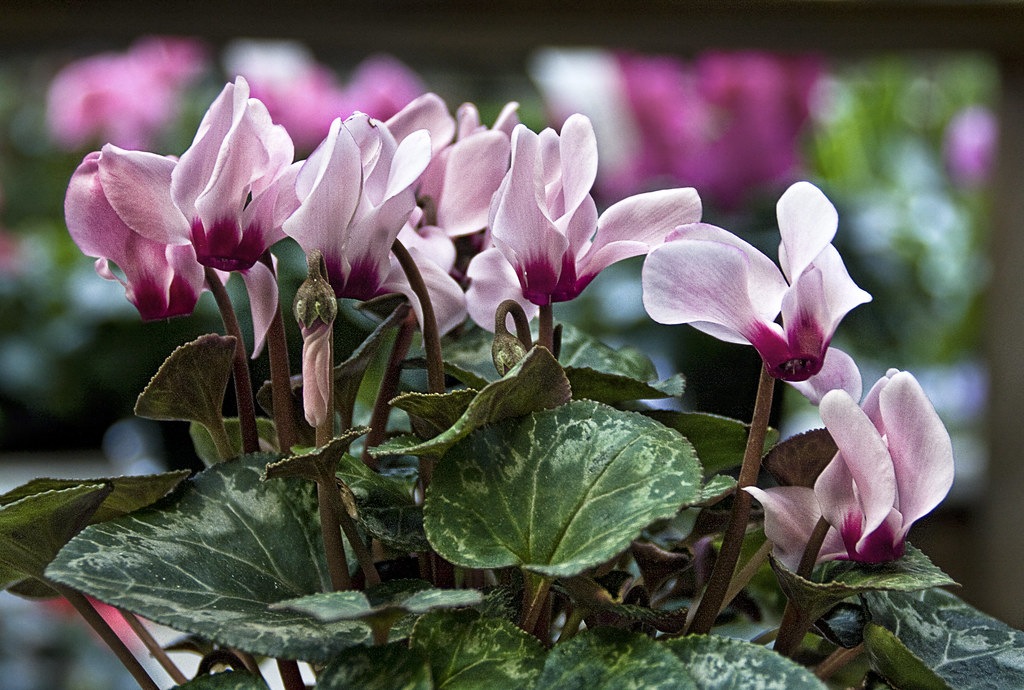
A florist’s cyclamen.
Cyclamen are perfect winter-blooming plants. Miniature varieties don’t take up much space, and they can fit in just about anywhere–a cool windowsill, the kitchen table, or a guest room. The cyclamen found in garden centers in autumn are florist’s cyclamen, which I’ll describe after the section on hardy cyclamen.
Now that we’re well into autumn, temperatures dip below freezing at night. Outdoor gardening activities are less critical, and preparing for the holidays takes priority.
Garden centers are brimful with enticing delights—real trees (fake ones, too) and wreaths and all the trimmings… Strings of miniature Christmas lights (“annuals”, according to some), bird feeders, seed and suet…
And plants, of course. Poinsettias in an ever-widening assortment of cultivars, paperwhite narcissus bulbs in bins or sprouting in pots, stately amaryllis in dozens of colors…and benches of cyclamen in sprightly pinks, reds, bicolors, and pure white.
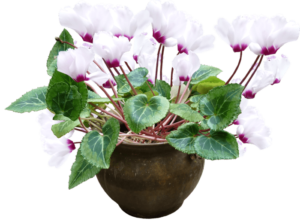 I’ve always loved miniature cyclamen. Sometimes you can find one with an especially delightful scent. The miniatures, to me, are easier to manage and stay in bloom longer than the larger types. A pink miniature from last Christmas just went out of bloom, yet summoned the energy to form 20 new flower buds.
I’ve always loved miniature cyclamen. Sometimes you can find one with an especially delightful scent. The miniatures, to me, are easier to manage and stay in bloom longer than the larger types. A pink miniature from last Christmas just went out of bloom, yet summoned the energy to form 20 new flower buds.
Now, they won’t bloom forever, but with careful maintenance, miniature cyclamen can bloom for many months.
Cyclamen are truly versatile. They easily fit into combination arrangements with Norfolk Island pine, English ivy, small poinsettias, and houseplants seeking company.
Grow them in rustic clay pots, in modern ceramics, in birch logs, and in baskets. Or clustered on the credenza with candles, amaryllis, and fresh greens. And near the front door, in the chilly foyer, under a desk lamp, with some ornaments, and, yes, more greens.
There are two groups of cyclamen: those that are hardy and can tolerate cold temperatures when planted in the garden (“Hardy Cyclamen”) and those that are grown for indoor culture (“Florist’s Cyclamen”).
Hardy Cyclamen—We Can Take the Cold
There are about two dozen species of cyclamen available to gardeners, all belonging to the Primulaceae family. In addition to Cyclamen, other members in the family include Primula, Lysimachia, Dodecatheon, and about 50 other genera.
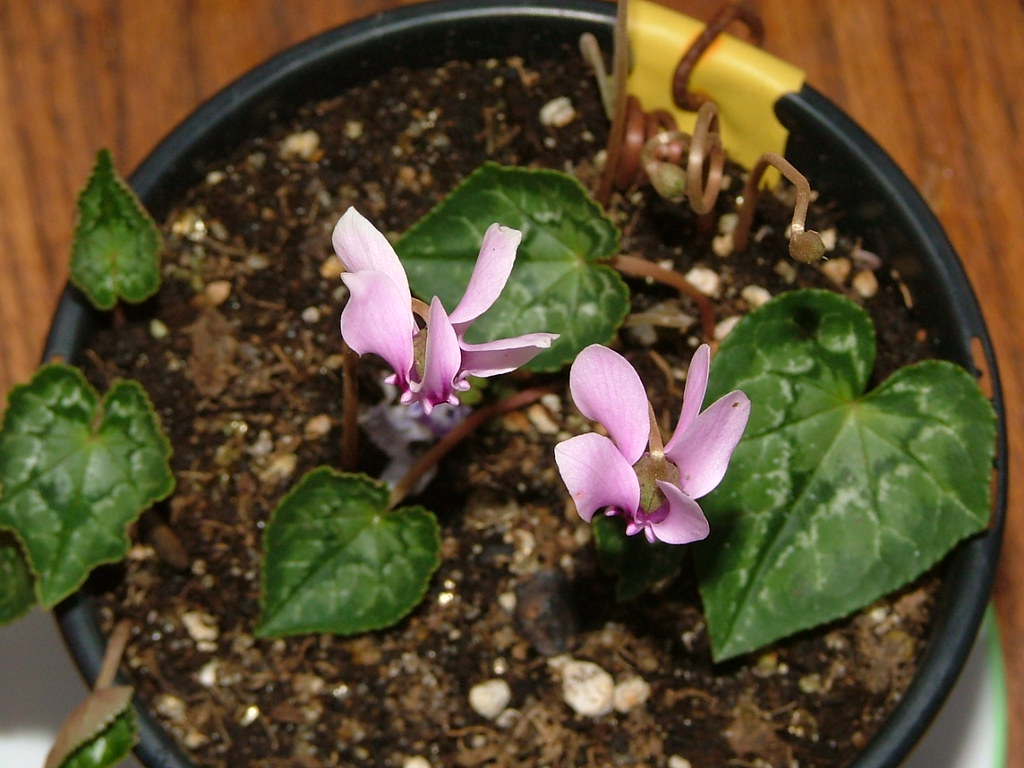
The hardy Cyclamen hederifolium.
Cyclamen Hederifolium
Cyclamen hederifolium is the most commonly found hardy cyclamen. The ivy-leaved cyclamen grows outdoors in USDA Zones 5 to 7, and can take temperatures down to -20°F. Its resemblance to English ivy (Hedera helix) explains the specific epithet, hederifolium.
Although it has naturalized in the Pacific Northwest, it is native to rocky woodlands and scrub in the Mediterranean region, from southern France to Turkey, and to islands in the Mediterranean Sea. This species is adaptable, readily self-seeds, and grows from sea level to about 4,000′ in elevation.
In late summer and autumn, pink flowers with darker eyes emerge among the silver-mottled leaves. Cyclamen needs gritty soil with lots of organic matter to keep it happy. Roots of this species emerge from the sides and the top of the tuber. Be careful not to cultivate the soil above the tuber, which will damage roots and the “floral trunks”, extensions of the tuber that bear flower buds.
Large tubers of the ivy-leaved cyclamen that I grew for sale arrived in mid summer. I potted them into 4½” pots, slightly bigger than the tubers. Half the soil consisted of drainage material. Coarse sand, pine fines, and small gravel (like PermaTill) mixed with potting soil in a 1:1 ratio encouraged roots to grow. But they rooted…very…slowly. Tubers rot in soil that holds too much water, so good soil preparation is important for long-term success.
Rooted In and Around
Decades ago, in Maryland, I planted a C. hederifolium tuber in a friend’s front yard, under a young Japanese maple. About 10 or 15 years later, she asked if it could be dug and taken to her new house. After some exploration, I felt a flattened tuber the size of a dinner-plate! But it was pinned in position by the aggressive roots of the maple tree.
It could not be pried loose, so it remains there today. Planted where the soil dries out while the tuber is dormant was probably part of the key to success. The maple absorbed a great deal of the water in spring and summer.
More Hardy Cyclamen Species
Here are some of the hardy cyclamen species, listed from more cold-tolerant first:
- hederifolium (USDA Zones 5-7): described above.
- coum (Zones 5 or 6 to 8): 4″ tall, small dark green or variegated leaves with deep red reverse. Pink to purple blooms appear in late winter to early spring. Similar to parviflorum, but coum grows at lower elevations in northern Turkey, and the two don’t hybridize.
- purpurascens (Zones 6-7): fragrant deep pink flowers in summer. Its silver-mottled foliage is nearly evergreen. Native to northern Italy and central Europe.
- cilicium (Zones 6-8): white to pale pink flowers in fall to winter, and silver-mottled leaves.
- mirabile (Zones 6-8): small flowers in autumn.
- parviflorum (Zones 6-9): a green-leaved species, from 4,000′ to 7900′ elevation (alpine tundra, subalpine meadow) in northern Turkey. Small tuber, only ¾” across.
- repandum (Zones 7-8): coarsely toothed leaf margins, silver-marbled.
- graecum (Zones 7-9): Greek cyclamen blooms in autumn with white or pink, often fragrant, flowers. From southern Greece and southern Turkey.
Collectors grow many of the species cyclamen, keeping them year-round in cool greenhouses. Information on websites varies regarding bloom time, flower color, and leaf color. Rare species and forms of species are available from specialty nurseries and garden clubs.
It takes a few years for cold-hardy species to flower from seed. In the wild, seeds are coated with a sweet sticky substance, which attracts ants. They feed on the sweet part, and discard the seeds. This method of seed dispersal, by ants, is called myrmecochory, in case you were wondering.
Because of dwindling native populations, be sure to ask for “nursery-propagated tubers”. This is not synonymous with “nursery-grown tubers”.
* * * * * * * *
Florist’s Cyclamen
This is the species that is most widely grown for indoor cultivation.
Cyclamen persicum comes from rocky hillsides, up to 3900′ elevation, in south-central Turkey, Israel, Jordan, and in parts of northern Africa. It is also found in some of the Greek islands, where monks grew it and introduced it to traders.
Native populations of this species had fragrant pink flowers. Although much of the fragrance has been lost in hybridization, some modern strains, especially the miniature and intermediate varieties, once again have some scent. They don’t throw scent far from their flowers, so smell the flowers before purchasing if fragrance is what you want.
Cyclamen are available in autumn, during the winter holidays, and for Valentine’s Day. In cool regions, some garden centers offer them in early spring.
Flowers come in a wide range of colors, including white, pink shades, salmon, scarlet, deep red, burgundy, lilac, and shades of purple. They can be solid or bicolor, or finely edged in a contrasting color (“picotee”). Breeders have come up with micro miniatures, miniatures, intermediates, and large-growing standard strains.
Foliage differs from one strain to another, some showing little silver mottling, and others showing bold silver variegation. Leaf margins can be smooth, lobed, or somewhat toothed. Flowers, too, can vary in form, from smooth to ruffled to fringed.
Keep cyclamen away from children and animals. Ingestion can cause abdominal distress, seizures, and even death.
Combinations
These were fast sellers where I attended winter farmers’ markets in Olney MD, around Washington, D.C., and at the Carroll County Christmas shows in Westminster, MD.
In a Basket
In cool conditions, group together cyclamen, kalanchoe, ‘Frosty’ fern, and lemon button fern. Add a small pot of English ivy to trail over the sides. Small grasses, such as mondo grass or Carex, add textural contrast to combinations.
I kept the plants in their pots, and snuggled them together in baskets lined with plastic. Add Spanish or green sheet moss, holiday ribbon or raffia, and maybe some small pine cones for the finishing touches.
Never allow water to collect in the bottom of a pot cover or a decorative container.
In a Pot
They also can be potted together. Use a shallow pot that snugly fits the root systems of the plants; keep them potbound.
The popular ‘Frosty’ fern, a Selaginella, develops white tips in cool conditions, and must be kept moist. More options include Norfolk Island pine, English ivy, and other plants that take the same conditions.
Clay pots allow soil to dry faster than non-porous pots. Potting cyclamen with other plants can be a bit tricky, especially if light levels are not optimal. Their tubers can rot in pots that are too large or if the soil is too wet.
Strains of Florist’s Cyclamen
Most customers aren’t concerned with the name of the cyclamen, but some are. A strain called Verrano tolerates higher, but not tropical, temperatures. The new Dreamscape strain performs well over a longer period of time. These are good choices for landscape beds in moderate to cool temperatures during the “shoulder” seasons, when they’re not exposed to frost.
A few of the miniature strains growers sell for indoors are Mini Winter (also good in cool, moist landscapes), Fantasia, and Snowridge Mini. Intermediate strains include Laser, Snowridge Midi, and Allure. For larger pots (5″ to 7″), growers offer Sierra, Mammoth, Fleur en Vogue, and Friller.
Strains with heavy silver variegation are beautiful even without flowers. Picasso (fragrant flowers) and Silverado are two popular miniature cyclamen strains. Rembrandt is an intermediate cyclamen, and Winter Ice is a larger standard with broad silver markings. Halios ‘White Silverleaf’ is a newer white-flowering cultivar with wide silver edging on the leaves. Metalis, an intermediate strain introduced in the 2020 California spring trials, has a broad silver margin, a green central heart, and can be used indoors and in the landscape.
Varieties coming to market are bred for leaf color, flower fragrance, and disease resistance. Breeders also are looking for larger bloom counts and for blooms that bunch in the center. Another variety in the 2020 spring trials is the heat tolerant ‘Leopardo’.
What About the Seedpods?
We normally remove faded flowers and their stems, encouraging more flowers to form. But, sometimes, for fun, I let seedpods develop at the end of the bloom cycle.
The flower stem curls curiously downward, and the pod splits open when the seeds are ripe. A fully developed seedpod resembles a grape.
Florist’s cyclamen grow quite easily from seed; they just take a long time to get to flowering size. Older strains of cyclamen needed 15 to 18 months from seed to flower. Newer varieties take only half that amount of time.
Seeds germinate soon after ripening if planted about ¼” deep. They germinate better in the dark, in high humidity, and with temperatures in the mid 60’s F. Tiny cyclamen leaves emerge after the tuber has begun to grow. I used to grow seedlings in 9-cell market packs until they were ready, months later, for 4″ pots. To save time, however, I purchased pre-finished cyclamen to sell at garden shows after they bulked up and came into flower.
Headings
Page 1: It’s Time For Cyclamen!, Hardy Cyclamen—We Can Take the Cold (Cyclamen Hederifolium, Rooted In and Around, More Hardy Cyclamen Species), Florist’s Cyclamen (Combinations, Strains Of Florist’s Cyclamen), and What About the Seedpods?
Page 2: Starting Out With Cyclamen, Choosing Cyclamen, Water, They Like It Cool (Miniature Cyclamen Might Be Easier), On a Chilly Porch, Dormancy, New Digs (Potting Soil), Fertilizer for Cyclamen, Light, Deadheading Cyclamen, and For Further Research
